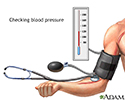Aging changes in vital signs
Vital signs include body temperature, heart rate (pulse), breathing (respiratory) rate, and blood pressure. As you age, your vital signs may change, depending on how healthy you are. Some medical problems can cause changes in one or more vital signs.
Checking your vital signs helps your health care provider monitor your health and any medical problems you may have.
BODY TEMPERATURE
Normal body temperature does not change much with aging. But as you get older, it becomes harder for your body to control its temperature. A decrease in the amount of fat below the skin makes it harder to stay warm. You may need to wear layers of clothing to feel warm.
Aging decreases your ability to sweat. You may have difficulty telling when you are becoming overheated. This puts you at high risk of overheating (heat stroke). You can also be at risk for dangerous drops in body temperature.
Fever is an important sign of illness in older people. It is often the only symptom for several days of an illness. See your provider if you have a fever that is not explained by a known illness.
A fever is also a sign of infection. When an older person has an infection, their body may not be able to produce a higher temperature. For this reason, it is important to check other vital signs, as well as any symptoms and signs of infection.
HEART RATE AND BREATHING RATE
As you grow older, your pulse rate is about the same as before. But when you exercise, it may take longer for your pulse to increase and longer for it to slow down afterward. Your highest heart rate with exercise is also lower than it was when you were younger.
Breathing rate usually does not change with age. But lung function decreases slightly each year as you age. Healthy older people can usually breathe without effort.
BLOOD PRESSURE
Older people may become dizzy when standing up too quickly. This is due to a drop in blood pressure with standing. This kind of drop in blood pressure when standing is called orthostatic hypotension. It is often related to medicines, particularly blood pressure drugs.
Risk of having high blood pressure (hypertension) increases as you get older. Other heart-related problems common in older adults include:
- Very slow pulse or very fast pulse
- Heart rhythm problems such as atrial fibrillation
EFFECTS OF MEDICINES ON VITAL SIGNS
Medicines that are used to treat health problems in older people can affect the vital signs. For example, the medicine digoxin, which is used for heart failure, and blood pressure medicines called beta-blockers may cause the pulse to slow.
Diuretics (water pills) can cause low blood pressure, most often when changing body position too quickly.
OTHER CHANGES
As you grow older, you will have other changes, including:
References
Southerland LT, Fath JJ. Geriatric trauma. In: Walls RM, ed. Rosen's Emergency Medicine: Concepts and Clinical Practice. 10th ed. Philadelphia, PA: Elsevier; 2023:chap 179.
Schiger DL. Approach to the patient with abnormal vital signs. In: Goldman L, Schafer AI, eds. Goldman-Cecil Medicine. 26th ed. Philadelphia, PA: Elsevier; 2020:chap 7.
Walston JD. Common clinical sequelae of aging. In: Goldman L, Schafer AI, eds. Goldman-Cecil Medicine. 26th ed. Philadelphia, PA: Elsevier; 2020:chap 22.
Aerobic exercise - illustration
Aerobic exercise
illustration
Taking your carotid pulse - illustration
Taking your carotid pulse
illustration
Radial pulse - illustration
Radial pulse
illustration
Warming up and cooling down - illustration
Warming up and cooling down
illustration
Effects of age on blood pressure - illustration
Effects of age on blood pressure
illustration
Aerobic exercise - illustration
Aerobic exercise
illustration
Taking your carotid pulse - illustration
Taking your carotid pulse
illustration
Radial pulse - illustration
Radial pulse
illustration
Warming up and cooling down - illustration
Warming up and cooling down
illustration
Effects of age on blood pressure - illustration
Effects of age on blood pressure
illustration
Review Date: 7/21/2022
Reviewed By: Frank D. Brodkey, MD, FCCM, Associate Professor, Section of Pulmonary and Critical Care Medicine, University of Wisconsin School of Medicine and Public Health, Madison, WI. Also reviewed by David C. Dugdale, MD, Medical Director, Brenda Conaway, Editorial Director, and the A.D.A.M. Editorial team.

















